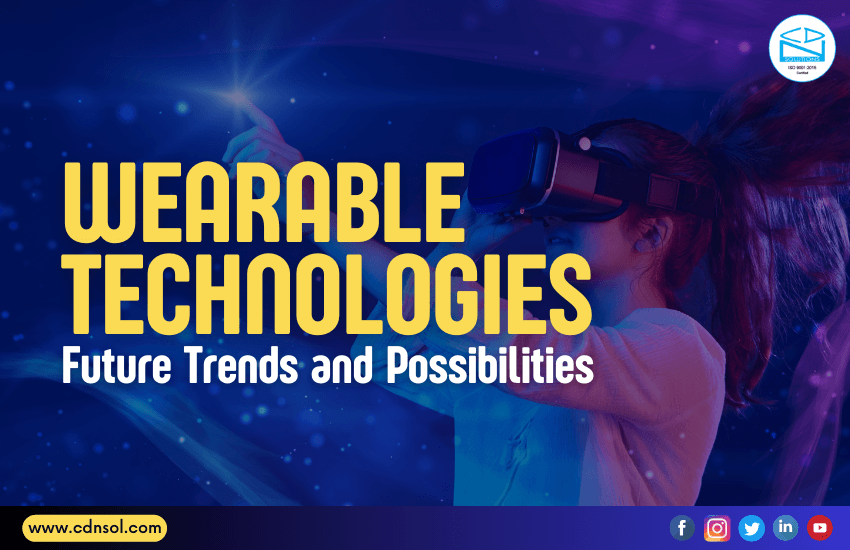Innovation, evolution, and integration of the latest technology are the three components that define wearable technologies. The market for wearable technology is rapidly expanding. From basic fitness trackers a decade ago, we now have sophisticated, multifunctional devices seamlessly integrated into our daily lives. Wearable brands are creating devices catering to specific features and niches.
Table of Contents
Before moving on to future trends, we must first understand the current state of wearable tech.
Communication, entertainment, health monitoring, and fitness tracking are the areas where wearable technology is in use. Smartwatches, fitness trackers, augmented reality glasses, and smart clothing exist.
Despite being rather outdated in terms of technology, wearables have started to alter trends in app development and adaptability to provide improved performance. According to research, the majority of adults worldwide now use wearable technology. It highlights the value of multiple user-friendly and useful features as well as cross-platform connections.
- Increased use and the adoption of the Internet of Things (IoT) are driving the growth of wearable technology.
- Technological literacy has fueled recent market growth and is likely to continue doing so in the coming years.
- Consumer awareness and increased purchasing power are encouraging further investment in wearable tech.
- Ongoing research and development are key drivers of industry growth, leading to innovative solutions and products.
- The future of wearable design looks promising due to this continued market expansion and the introduction of advanced features.
Future Trends in Wearable Technology
As we look toward the future, wearable technology promises to be transformative, likely redefining our interactions with technology and each other. Here are some possible emerging trends and future possibilities:
Health Monitoring and Medical Applications
Advancement in health monitoring and medical applications is likely the most promising trend.
Healthcare wearables will be used for basic fitness tracking. Data will be more detailed and real-time health data.
- Wearable tech may soon monitor blood glucose non-invasively, improving the lives of diabetics.
- Wearables with sensors can detect early signs of diseases like Parkinson’s or Alzheimer’s, leading to early intervention and better patient outcomes.
- AI integrated with wearables could revolutionize personalized healthcare by providing tailored health advice and flagging anomalies to medical professionals.
These trends will enhance preventive care and facilitate remote patient monitoring, reducing the need for frequent hospital visits and making healthcare more accessible.
AR (Augmented Reality) and VR (Virtual Reality)
AR and VR abilities of wearable technologies will significantly advance. AR spectacles like Microsoft HoloLens and Google Glass have set the foundation. The experiences offered by next-generation wearables will be more engaging and dynamic. Gaming and entertainment will be revolutionized. Significant impact will be in the manufacturing, healthcare, and education sectors.
- AR and VR wearables to offer interactive learning with 3D models and virtual simulations.
- AR glasses to allow surgeons access data and see procedures in real-time for better outcomes.
- Augmented reality instructions for workers enhance efficiency and reduce errors.
Smart Fabrics (E-Textiles)
The development of smart fabrics and e-textiles is another exciting trend. Electronic components to be integrated directly into clothing. Advanced materials can monitor parameters, give feedback, or change properties. Smart fabrics will revolutionize the sports, healthcare, and fashion sectors.
- Smart clothing offers detailed biomechanical data, enhancing athletic performance and injury prevention
- E-textiles to offer continuous, comfortable vital sign monitoring.
- The fashion industry explores smart fabrics for customized designs.
Internet of Things (IoT) Integration
The Internet of Things (IoT) is expanding exponentially. Wearables will become an integral part of this interconnected IoT ecosystem. Future wearables will interact with a wide range of IoT devices. Flawless, personalized experience via integration.
- Wearable devices can detect your daily activity and adjust your smart home system according to your preferences.
- Smartwatch interacts with the car, unlocks the doors, and adjusts the seat and mirrors to your preferences.
Such seamless interactions of wearable and IoT will enhance convenience and efficiency and make daily routines smoother and more enjoyable.
Beyond Technology, Social and Cultural Impact
Wearable technology also has the potential to impact society and culture at large.
- Change in Social Norms: Wearable tech may redefine social norms, and change social interactions, just like smartphones did with communication.
- Enhanced Accessibility and Inclusivity: Wearable technology enhances accessibility for individuals with disabilities. Smart glasses aid hearing-impaired and language-barrier individuals via real-time transcription or translation. Wearables aid visually impaired navigation, fostering accessibility and inclusivity.
- Redefined Personal Health and Wellness: With wearables becoming more sophisticated, they can promote personal health management. Insights promote proactive health choices. Preventive care eases the healthcare burden and improves public health. Wearables promote community and support through social sharing and virtual health challenges.
Conclusion
The future of wearable technology is brimming. Exciting possibilities and transformative potential are expected. Wearables are set to become an essential part of daily life, offering health monitoring, AR experiences, smart fabrics, and IoT integration. Realizing potential requires addressing challenges like privacy, security, battery life, and accessibility
Wearable tech reshapes life socially, not just personal experiences. Wearables can connect, inform, and improve society’s health. Wearable tech’s future impact goes beyond devices and data, shaping lives and the world.
Also read: From fiction to realities: Wearable technological innovations that were once imagination
Also read: Wearable: The Future of Health Tech
Also read: Privacy and Security Challenges in Wearable Technologies

